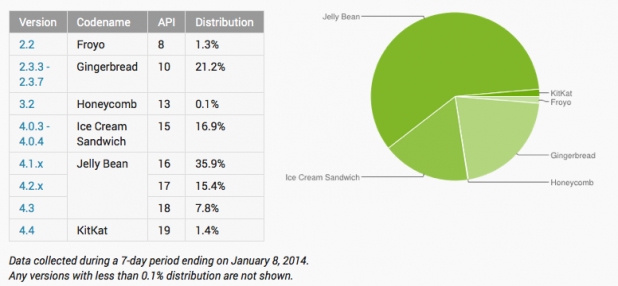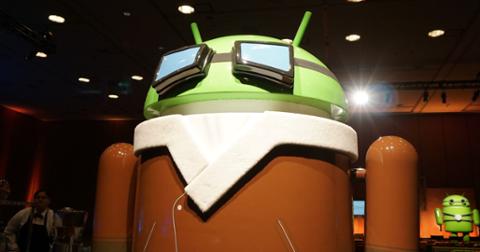
The second-most-recent version of Google’s popular Android operating system (codenamed “Jelly Bean”) holds just under 60 percent of the market, according to new statistics from the search-engine giant, while the latest version (“KitKat”) holds a mere 1.4 percent. Much earlier versions of Android, “Gingerbread” (v. 2.3.3 through 2.3.7) and “Ice Cream Sandwich” (4.0.3 through 4.0.4), still hold 21.2 percent and 16.9 percent of the market, respectively. Google collects data on devices running the Google Play app, which connects to the company’s apps-and-media hub, and is compatible with Android 2.2 and higher. On its
Android Developers Website, Google periodically releases “snapshots” of data from all devices that visited Google Play within the past week. This latest snapshot represents data collected through January 8. Google collects data on far more than OS versions; it also collects some choice feedback about hardware. Despite the popularity of extra-large smartphones, “normal” size screens continue to dominate the Android market, at 78 percent of all devices. Small-screen devices comprise 8.2 percent of the total, trailing “large” screens at 8.4 percent but trending well ahead of “extra large” screens at 5.4 percent. Some 93.5 percent of Android devices support version 2.0 of OpenGL ES, while a mere 0.1 percent support version 1.1; another 6.4 percent support version 3.0. OpenGL ES is a subset of the OpenGL CG-rendering API for embedded systems such as tablets and smartphones; it’s an important data-point for developers who might be viewing this latest Google data. (“To declare which version of OpenGL ES your application requires, you should use the
android:glEsVersion attribute of the
<uses-feature> element,” added the
Android Developers page. “You can also use the
<supports-gl-texture> element to declare the GL compression formats that your application uses.”) For years, Google’s critics have complained that the Android operating system has a fragmentation problem, with too many manufacturers installing too many versions of the software on too many phones. Some customers were stuck with Android smartphones running an antiquated version of the software (such as “Gingerbread”), with no updates in sight; others had Android devices pre-loaded with “crapware” and pointless apps. Android 4.4 (“KitKat”), released late last year, was designed to help address some of those criticisms. KitKat includes tight integration with Google Now (Google’s voice-activated digital assistant) and a messaging interface that consolidates everything from SMS texts to video calls into a single hub, among other features. But Google’s secret weapon in its battle against fragmentation (and Apple’s iOS) is KitKat’s ability—thanks to a minimization of resource-hungry processes—to run on low-end devices, which represent Android’s fastest-growing segment. In time, that means KitKat might eventually dominate the Android ecosystem; but based on these latest figures, that date could still be relatively far in the future.
Image: Google
 The second-most-recent version of Google’s popular Android operating system (codenamed “Jelly Bean”) holds just under 60 percent of the market, according to new statistics from the search-engine giant, while the latest version (“KitKat”) holds a mere 1.4 percent. Much earlier versions of Android, “Gingerbread” (v. 2.3.3 through 2.3.7) and “Ice Cream Sandwich” (4.0.3 through 4.0.4), still hold 21.2 percent and 16.9 percent of the market, respectively. Google collects data on devices running the Google Play app, which connects to the company’s apps-and-media hub, and is compatible with Android 2.2 and higher. On its Android Developers Website, Google periodically releases “snapshots” of data from all devices that visited Google Play within the past week. This latest snapshot represents data collected through January 8. Google collects data on far more than OS versions; it also collects some choice feedback about hardware. Despite the popularity of extra-large smartphones, “normal” size screens continue to dominate the Android market, at 78 percent of all devices. Small-screen devices comprise 8.2 percent of the total, trailing “large” screens at 8.4 percent but trending well ahead of “extra large” screens at 5.4 percent. Some 93.5 percent of Android devices support version 2.0 of OpenGL ES, while a mere 0.1 percent support version 1.1; another 6.4 percent support version 3.0. OpenGL ES is a subset of the OpenGL CG-rendering API for embedded systems such as tablets and smartphones; it’s an important data-point for developers who might be viewing this latest Google data. (“To declare which version of OpenGL ES your application requires, you should use the
The second-most-recent version of Google’s popular Android operating system (codenamed “Jelly Bean”) holds just under 60 percent of the market, according to new statistics from the search-engine giant, while the latest version (“KitKat”) holds a mere 1.4 percent. Much earlier versions of Android, “Gingerbread” (v. 2.3.3 through 2.3.7) and “Ice Cream Sandwich” (4.0.3 through 4.0.4), still hold 21.2 percent and 16.9 percent of the market, respectively. Google collects data on devices running the Google Play app, which connects to the company’s apps-and-media hub, and is compatible with Android 2.2 and higher. On its Android Developers Website, Google periodically releases “snapshots” of data from all devices that visited Google Play within the past week. This latest snapshot represents data collected through January 8. Google collects data on far more than OS versions; it also collects some choice feedback about hardware. Despite the popularity of extra-large smartphones, “normal” size screens continue to dominate the Android market, at 78 percent of all devices. Small-screen devices comprise 8.2 percent of the total, trailing “large” screens at 8.4 percent but trending well ahead of “extra large” screens at 5.4 percent. Some 93.5 percent of Android devices support version 2.0 of OpenGL ES, while a mere 0.1 percent support version 1.1; another 6.4 percent support version 3.0. OpenGL ES is a subset of the OpenGL CG-rendering API for embedded systems such as tablets and smartphones; it’s an important data-point for developers who might be viewing this latest Google data. (“To declare which version of OpenGL ES your application requires, you should use the 

